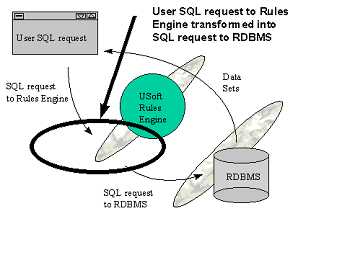|
When SQL statements are executed
within a USoft application, these statements are processed at Rules
Engine level and, if needed, also at database level.
First, the SQL statement (e.g.
the constraint text) is submitted to the Rules Engine. This SQL
could be termed "Rules Engine SQL". The Rules Engine processes this
SQL statement and attempts to execute it using information that is
already available on the client computer.
If it turns out that server
data is required, the Rules Engine proceeds to build a SQL
statement to be processed by the RDBMS. This could be termed
RDBMS SQL.
In USoft BenchMark, in the
Test Profiles window, the SQL Statements tab page shows both Rules
Engine SQL and RDBMS SQL:
|
·
|
Rules Engine SQL is shown in the SQL Statement field. |
|
·
|
RDBMS SQL is shown in the RDBMS SQL Statement field. |
You can also view RDBMS SQL
statements if you use BenchMark's Tracer facility.
Once received by the RDBMS, a
second optimization round takes place as a standard RDBMS
procedure. This optimization is, of course, not Rules Engine
specific but it is specific to the database you use.
As a general rule, the Rules
Engine optimizes SQL statements by maximizing local evaluation. If the statement
requires data that is already known on the client, then no RDBMS
SQL statements need to be produced, and nothing is sent to the
server. If statements are sent to the server, attempts are made to
keep processing down to a minimum.

Rules Engine SQL Optimization
Related Topics
Row Binding
Local Values
Update Change Check
Resolving Void Conditions
Local SQL Functions
Set Oriented Manipulations
Large Numbers
No Childless Parent Cascade
|

